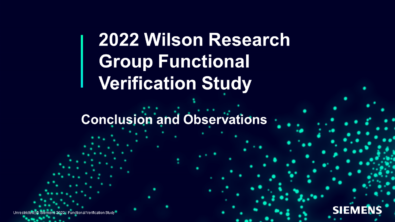Epilogue: The 2012 Wilson Research Group Functional Verification Study
Wow! I’ve been on the road since August, and finally found a spare moment to get back to this blog. I started this blog series with a prologue that gave a little bit of background on the 2012 Wilson Research Group study. And with this epilogue, I will draw the series to a conclusion with some insight on the study process. Many people are cynics about industry studies in general (and particularly ones based on surveys) and believe that they are inaccurate, unreliable, and biased. However, I believe that the benefit from an industry study is not necessarily the quantitative values that the answers reveal, but the new questions they raise.
With that said, it is important to understand that the 2007 FarWest Research study and the 2010 and 2012 Wilson Research Group studies followed the format of the original 2002 and 2004 Ron Collett International studies, which have certain limitations. For example, the Collett studies were very block-, IP-, and RTL-focused studies. The data that these studies revealed certainly is of value and important, but it doesn’t represent some of the challenges in SoC integration verification and system validation that have recently emerged. In fact, many of the techniques used for block and subsystem verification that these surveys studied (such as constrained-random, functional coverage, general formal property checking) do not scale well to the SoC integration and system-level validation space. I believe that future studies should be expanded to include these emerging challenges.
Another criticism of all the previous studies is that the presented data is aggregated across all market segments—ranging from mil/areo, mobile, consumer, networking, computers, and so forth. Hence, it can be difficult for those in a particular market segment to benchmark themselves against or relate to the study data. This is a valid argument. With our two recent Wilson Research studies, it is possible to filter the data down for presentation to a specific market segment. However, it is not possible with the previous studies.
Nonetheless, there is still value in observing general industry trends between the multiple studies as long as the format of the studies is consistent. Consistency is something we strived for across the studies. For example, whenever possible, we tried to maintain the exact wording of the questions originally used in the Collett studies.
Minimizing Study Biases
When architecting a study, there are three main concerns that must be addressed to ensure valid results: (1) sample validity, (2) non-response bias, (3) stakeholder bias. I’ll briefly review each of these concerns in the following paragraphs, and discuss steps we took to try and minimize the bias concerns.
(1) Sample validity or undercoverage bias: To ensure that a study is unbiased, it’s critical that every member of a studied population have an equal chance of participating. An example of a biased study would be when a technical conference surveys its participants. The data might raise some interesting questions, but unfortunately, it doesn’t represent members of the population that was unable to participant in the conference. They same bias can occur if a journal or online publication simply surveys its subscribers.
A classic example of this problem is the famous Literary Digest poll in the 1936 presidential election, where the magazine surveyed over two million people. This was a huge study for this period in time. The pool (or make-up) of the study was chosen from the magazine’s subscriber list, phone books, and car registrations. However, the problem with this approach was that the study did not represent the actual voter population since it was a luxury to have a subscription to a magazine, or a phone, or a car during The Great Depression. As a result of this biased sample, the poll inaccurately predicted that Republican Alf Landon versus the Democrat Franklin Roosevelt would win the 1936 presidential election.
For the 2012 Wilson Research Group study, we carefully chose a broad set of lists that, when combined, represented all regions of the world and all electronic design market segments. We reviewed the participant results in terms of market segments to ensure no segment or region representation was inadvertently excluded or under-represented.
(2) Non-response bias: Non-response bias in surveys occurs when a randomly sampled individual cannot be contacted or refuses to participate in a survey. For example, spam and unsolicited mail filters remove an individual from the possibility of receiving an invitation to participate in a survey, which can bias results. It is important to validate sufficient responses occurred across all list that make up the study pool. Hence, we reviewed the final results to ensure that no single list of respondents that made up the participant pool dominated the final results.
Another potential non-response bias is due to lack of language translation. In fact, we learned this during the 2012 Wilson Research Group study. The study generally had good representation from all regions of the world, with the exception of an initially very poor level of participation from Japan. To solve this problem, we took two actions: (1) we translated both the invitation and the survey into Japanese, (2) we acquired additional engineering lists directly from Japan to augment our existing survey invitation list. This resulted in a balanced representation from Japan.
(3) Stakeholder bias: Stakeholder bias occurs when someone who has a vested interest in survey results can complete an online survey multiple times and urge others to complete the survey in order to influence the results. To address this problem, a special code was generated for each study participation invitation that was sent out. The code could only be used once to fill out the survey, preventing someone from taking the study multiple times, or sharing the invitation with someone else.
2010 Study Bias
After analyzing the results from the 2012 study we are confident that the study was balanced across market segments and regions of the world, which was our goal. However, while architecting the 2012 study, we did discover a non-response bias associated with the 2010 study. Although multiple lists across multiple market segments and across multiple regions of the world were used during the 2010 study, we discovered that a single list dominated the responses, which consisted of participants who worked on more advanced projects and whose functional verification processes tend to be mature. For example, as a result of this bias, if you look at Figure 3 concerning languages used to create testbenches, the industry-wide adoption of SystemVerilog is likely less than what was shown for 2010. This means that the industry adoption between 2010 and 2012 would have increased slightly more than indicated, and the growth between 2007 and 2010 would have been slightly less.
The 2007 study, like the 2012 study, was well balance and did not exhibit the non-response bias previously described for the 2010 data. Hence, we have confidence in talking about general industry trends between 2007 and 2012. The 2010 data can still be useful as a reference point during discussion if you keep in mind that it represents a more process-mature segment of the population.
Our plan is to commission a new study in 2014. At that point, we should have sufficient data to start showing trends in the FPGA space (something we have not been able to do yet) and have a clearer picture of emerging trends in the non-FPGA space. However, as previously stated, the emerging challenges today are occurring in the SoC integration verification and system-level validation space. We will either reduce the scope of our existing IP/RTL-focused study to make room for new questions in these spaces, or conduct a separate, rigorous study for these new emerging challenges.
Final word—I hope the data presented in this set of blogs has provided some insight on general trends. But more importantly, I hope it has inspired you with questions about your own processes that you might want to investigate.


